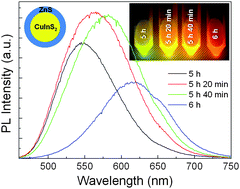Facile, air-insensitive solvothermal synthesis of emission-tunable CuInS2/ZnS quantum dots with high quantum yields†
Abstract
Yellow-to-red emitting CuInS2/ZnS (CIS/ZnS) core/shell

* Corresponding authors
a
Department of Materials Science and Engineering, Hongik University, Seoul, Republic of Korea
E-mail:
hyang@hongik.ac.kr
Tel: +82-2-320-3039
Yellow-to-red emitting CuInS2/ZnS (CIS/ZnS) core/shell

 Please wait while we load your content...
Something went wrong. Try again?
Please wait while we load your content...
Something went wrong. Try again?
D. Nam, W. Song and H. Yang, J. Mater. Chem., 2011, 21, 18220 DOI: 10.1039/C1JM12437D
To request permission to reproduce material from this article, please go to the Copyright Clearance Center request page.
If you are an author contributing to an RSC publication, you do not need to request permission provided correct acknowledgement is given.
If you are the author of this article, you do not need to request permission to reproduce figures and diagrams provided correct acknowledgement is given. If you want to reproduce the whole article in a third-party publication (excluding your thesis/dissertation for which permission is not required) please go to the Copyright Clearance Center request page.
Read more about how to correctly acknowledge RSC content.
 Fetching data from CrossRef.
Fetching data from CrossRef.
This may take some time to load.
Loading related content
